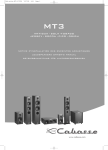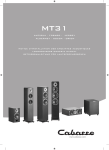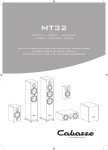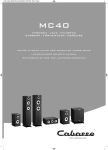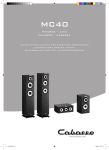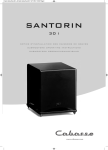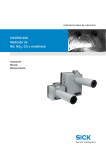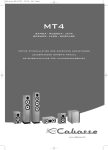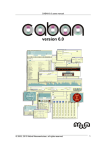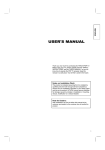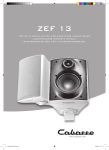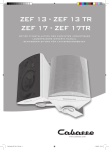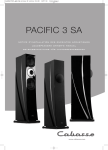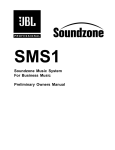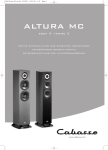Download antigua • tobago • jersey alderney • socoa • pico • orion
Transcript
OK-notice-MT30:OK-notice-MT30 03/12/09 18:30 Page1 MT30 antigua • tobago • jersey alderney • socoa • pico • orion notice d’installation des enceintes acoustiques loudspeakers owner’s manual betriebsanleitung für lautsprecherboxen www.cabasse.com OK-notice-MT30:OK-notice-MT30 03/12/09 18:31 Page2 f r a n ç a i s e n g l i s h d e u t s c h 1 2 3 d 4 d> 1,5 m /d >5 ft d 6 5 OK-notice-MT30:OK-notice-MT30 03/12/09 18:31 Page3 7 7 Cinch RCA LINE IN Cinch RCA LINE IN / Cinch RCA LINE IN Buchsen 8 Cinch RCA LINE OUT Cinch RCA LINE OUT / Cinch RCA LINE OUT Buchsen 9 Bornes haut-parleurs FROM RECEIVER (amplificateur) FROM RECEIVER connectors / FROM RECEIVER (vom Verstärker) 0 Bornes haut-parleurs TO SPEAKERS (vers enceintes) TO SPEAKERS connectors / TO SPEAKERS (zu den Lautsprechern) - Alimentation secteur / Power supply / Netzstecker = Commutateur 115 / 230 V AC voltage selector / Betriebspannungsshalter q Interrupteur POWER / POWER / NETZ SHALTER w Réglage VOLUME / VOLUME / LAUTSTÄRKEREGLER e Réglage de la fréquence de coupure - CROSSOVER CROSSOVER / ÜBERGANGSFREQUENZREGLER r PHASE / PHASE / PHASE 7 w e 8 r q - = Amplificateur / Amplifier / Verstäker ORION R L OK-notice-MT30:OK-notice-MT30 03/12/09 18:31 Page4 f r a n ç a i s Vous venez d’acheter des enceintes Cabasse et nous vous remercions de votre confiance. Dans le but d’optimiser au maximum votre installation, nous vous recommandons de lire attentivement cette notice. INSTRUCTIONS DE SECURITE Explication des symboles L’éclair dans un triangle équilatéral avertit de l’existence de tension élevée dangereuse non isolée à l’intérieur du coffret du produit, d’une valeur suffisante pour présenter un risque d’électrocution. Le point d’exclamation dans un triangle équilatéral avertit de l’existence d’instructions importantes quant à l’utilisation et la maintenance dans la documentation jointe à ce produit. Instructions - Toutes les instructions de sécurité et d’utilisation doivent avoir été lues avant d’allumer tout appareil pour la première fois. Retenez les instructions - Elles doivent servir de référence permanente pour tout ce qui suit. Tenez compte des avertissements - Les avertissements présents sur le produit ou dans les notices d’utilisation doivent être pris en compte. Suivez les instructions - Toutes les instructions d’utilisation et de mise en œuvre doivent être scrupuleusement suivies. Nettoyage - Débranchez l’appareil avant tout nettoyage. N’utilisez pas de solutions nettoyantes sous forme liquide ou en aérosols. Employez de préférence un chiffon humide. Accessoires - N’utilisez pas d’accessoires qui ne soient pas explicitement recommandés par le constructeur, sous peine de risquer divers accidents. Eau et humidité - L’appareil ne doit pas être utilisé près de l’eau, par exemple à proximité d’une baignoire, d’un évier, dans un sous-sol humide, près d’une piscine, ou de tout ce qui y ressemble de près ou de loin. Chariots et supports - La manutention doit être effectuée seulement avec des chariots et supports agréés par le fabricant. > Attention aux chariots de manutention Installation sur mobiliers et supports - Ne placez pas cet appareil sur un support instable, qu’il s’agisse de pieds, trépieds, tables, étagères, etc. Il pourrait tomber et causer des blessures sérieuses à un enfant ou un adulte qui se trouverait à proximité. Ventilations - L’appareil doit être positionné de telle sorte qu’il ne gêne pas sa propre ventilation. Par exemple, il ne doit pas être installé sur un lit, un canapé, une couverture ou des surfaces similaires qui pourraient bloquer ses orifices d’aération. Il ne doit pas non plus être encastré dans des enceintes confinées comme des étagères étroites ou des meubles qui pourraient limiter la quantité d’air disponible aux entrées d’air. Alimentation - L’appareil ne doit être relié qu’à une source électrique du type écrit dans le mode d’emploi ou conforme à la sérigraphie sur le produit. Si vous n’êtes pas sûr du type de courant fourni à l’endroit où vous vous trouvez, adressez-vous à votre revendeur ou à la compagnie électrique locale. Protection des câbles d’alimentation - Le cheminement des câbles d’alimentation doit être prévu de telle sorte qu’ils ne puissent pas être piétinés, pincés, coincés par d’autres appareils posés dessus, et une attention toute particulière doit être accordée à l’adéquation des prises et à la liaison du cordon avec l’appareil. Foudre - Pour une meilleure protection de l’appareil pendant les orages ou s’il doit rester inutilisé pendant une longue période, débranchez le cordon d’alimentation et débranchez la prise d’antenne, vous éviterez ainsi les risques de détérioration dus à la foudre ou aux surtensions. Surcharges électriques - Ne surchargez pas les prises d’alimentation, les prolongateurs ou les rappels d’alimentation. Il pourrait en résulter incendies ou électrocutions. Corps et liquides étrangers - On doit être attentif à ne jamais laisser entrer d’éléments ou de liquides étrangers dans l’appareil. Ils pourraient occasionner incendies ou électrocutions. Ne versez jamais aucun liquide d’aucune sorte sur l’appareil. Entretien - L’utilisateur ne doit pas tenter de s’occuper des opérations de maintenance au-delà de celles décrites dans le mode d’emploi. Tout ce qui dépasse le simple niveau de l’entretien doit être effectué par un personnel qualifié. Maintenance - Dans les cas suivants, vous devez impérativement débrancher votre appareil et le faire vérifier par un technicien qualifié : ■ l’alimentation ou la prise a été endommagée. ■ des corps étrangers ou du liquide se sont introduits dans l’appareil. ■ l’appareil a été exposé à la pluie ou a été aspergé d’eau. ■ l’appareil ne semble pas marcher correctement alors que vous l’utilisez dans le cadre de ses instructions de fonctionnement normal. Ne manipulez que les contrôles couverts par le mode d’emploi. Toute autre procédure pourrait le détériorer et nécessiter l’intervention d’un technicien qualifié. ■ l’appareil est tombé ou bien sa carrosserie est endommagée. ■ l’appareil affiche des performances nettement modifiées. Pièces détachées - Si la réparation a nécessité l’utilisation de pièces détachées, assurez-vous que le technicien a bien utilisé les références préconisées par le fabricant ou présentant les mêmes caractéristiques que les pièces originales. Des pièces non conformes peuvent provoquer incendies, électrocutions ou autres. Vérifications - Après toute intervention sur l’appareil, demandez au technicien d’effectuer des tests afin de garantir que l’appareil fonctionne en toute sécurité. Exposition aux fortes températures - L’appareil doit être tenu éloigné de sources de chaleur comme radiateurs, chauffage divers, amplificateurs, ou tous autres éléments susceptibles de le placer dans des conditions de températures anormaleAttention ment élevées. Avant tout branchement, Sacs plastiques - Ne pas laiss’assurer que votre ser les sacs plastiques de l’emtension secteur correspond bien à la tension ballage à portée des enfants afin secteur sélectionnée sur le d’éviter tout risque d’étouffement. commutateur 115 V - 230 V t. Valable aux USA, au Canada et autres pays concernés Attention ! pour éviter les chocs électriques, introduire la lame la plus large de la fiche dans la borne correspondante et pousser jusqu’au fond OK-notice-MT30:OK-notice-MT30 03/12/09 18:31 Page5 f r a n ç a i s DEBALLAGE DES ENCEINTES 1 Ouvrir le côté mentionné sur le carton, replier sur les cotés les rabats supérieurs du carton et retirer le cache de l’enceinte. Puis retourner l’emballage avec son contenu, vider le carton de son contenu et sortir l’enceinte de son emballage. Nous vous conseillons de conserver l’emballage de votre enceinte à plat pour une utilisation ultérieure éventuelle. POSITIONNEMENT ET PLACEMENT DES ENCEINTES ACOUSTIQUES Positionnement des enceintes Nos enceintes acoustiques sont prévues pour fonctionner en position verticale, afin de respecter la courbe polaire des haut-parleurs. La plupart de nos modèles sont livrés avec un jeu de pointes ou cônes de découplage 2. Ces accessoires sont à visser dans l’emplacement prévu sous vos enceintes. Ces pointes ou cônes de découplage permettent d’assurer une meilleure stabilité de l’enceinte tout en limitant les résonances pouvant être générées par certains types de sols comme les planchers par exemple. Les enceintes sont livrées avec un tissu de protection en face avant. II est possible de les utiliser sans ce tissu. Enlevez le cadre en exerçant une légère traction horizontale sur sa partie supérieure pour rompre sa liaison magnétique avec l’ébénisterie de votre enceinte. Pour remettre le cadre en place, présentez le devant la face avant de l’enceinte et approcher doucement le cadre jusqu’à ce que les liaisons magnétiques soient établies. Procédez à ces opérations délicatement pour éviter une usure prématurée de la partie du revêtement couvrant les aimants insérés sur la face avant de l’ébénisterie. Nous vous recommandons de garder cette protection en place pour mieux protéger les haut-parleurs de votre enceinte3. Le champ magnétique des moteurs des haut-parleurs va rayonner au delà de l’enveloppe de l’enceinte acoustique. Il faut donc éloigner d’environ 50 cm les appareils et objets sensibles à ce type de rayonnement (téléviseurs, écrans d’ordinateur, disquettes informatiques, bandes magnétiques audio ou vidéo, cartes à puces...). Les enceintes centrales ne sont pas concernées par ce type de problème car elles sont blindées magnétiquement. Placement des enceintes dans une pièce Outre la position des enceintes, il faut tenir compte de leur emplacement dans la pièce, les propriétés acoustiques d’un local étant un facteur capital dans la retransmission du son. Le placement optimal pour une écoute stéréo classique 2.04 Si l’on considère que d est la distance qui sépare les deux enceintes, celle-ci doit être supérieure à 1,5 m. Les deux enceintes doivent être à égale distance de la zone d’écoute qui forme avec elles un triangle équilatéral. ■ ■ Les haut-parleurs doivent être dirigés vers la zone d’écoute. ■ Les enceintes doivent, de préférence, diffuser dans le sens de la plus grande dimension de la pièce. D’une façon générale, on doit éviter de positionner les enceintes dans les coins d’une pièce, car la disposition en angle favorise Ies fréquences graves. De même, les enceintes doivent se situer à une distance d’au moins 20 cm du mur. ■ Toujours dans le but d’obtenir une réponse équilibrée, il est recommandé de surélever les enceintes compactes d’environ 30 à 40 cm du sol avec des supports pour enceintes, les tweeters de l’enceinte devant se situer approximativement à la hauteur des oreilles de l’auditeur lorsque celui-ci est en position assise. ■ Aucun élément (table, fauteuil...) ne doit gêner la propagation directe entre les enceintes et l’auditeur. Un effet de masque, même partiel, déséquilibre complètement la reproduction sonore car il provoque une atténuation des fréquences aiguës et dans la majorité des cas des médiums également. ■ La disposition des enceintes dans des niches est également en général à proscrire car elle modif ie la courbe de réponse de l’enceinte, particulièrement dans les fréquences basses. S’il est impossible d’adopter une autre disposition, on doit veiller à ce que l’enceinte s’encastre avec le minimum de jeu dans la niche, pour éviter l’apparition de résonances diverses. Par ailleurs, la partie visible du tissu devra être à l’extérieur de la niche. ■ Le placement optimal pour une écoute stéréo en 2.15 Dans le cadre d’une écoute stéréo avec 2 enceintes ou 2 satellites et 1 caisson de graves, nous vous conseillons de placer le caisson de graves dans la zone écoute avant. Le placement du caisson contre un mur renforce l’extrême grave et limite les réflexions de 80 à 200 Hz. Cependant, pour obtenir le meilleur résultat, il est toujours nécessaire de faire des essais d’emplacement en fonction de l’acoustique de la pièce. Le placement optimal pour une écoute Home Cinéma ou 5.16 Pour la disposition d’un ensemble home cinéma, il est important d’apporter la plus grande attention à la disposition des enceintes supplémentaires spécifiques. ■ L’enceinte centrale doit être placée le plus près possible de l’écran en recherchant la position dans le lieu d’écoute qui apporte la plus grande cohésion sur les dialogues entre le son et I’image. En pratique, cela revient à placer l’enceinte centrale au-dessus de l’écran si les enceintes principales sont plus basses que celui-ci, et en dessous si les enceintes principales sont plus hautes. Les enceintes arrière, voies d’effet ou surround doivent être disposées contre les murs latéraux, légèrement en hauteur. Elles doivent être situées légèrement en arrière de la zone d’écoute. ■ Le caisson de graves doit être placé dans la zone d’écoute avant. Son placement contre un mur renforce l’extrême grave et limite les réflexions de 80 à 200 Hz. Cependant, pour obtenir le meilleur résultat, il est toujours nécessaire de faire des essais d’emplacement en fonction de l’acoustique de la pièce. ■ Votre amplificateur audio-vidéo permet le réglage des niveaux et des distances de chaque enceinte. Ce réglage doit être ajusté avec soin de manière à obtenir une parfaite cohésion entre les sources sonores. Il est nécessaire d’éteindre tous les appareils avant la connexion des enceintes. Pour le branchement de vos enceintes acoustiques, il faut tenir compte de la section des câbles et du respect des phases. BRANCHEMENT Section des câbles Distance ampli - enceinte Section 4,5 m 1,5 mm 2 Pour conserver toutes les 6m 2 mm 2 qualités des enceintes 7,5 m 2,5 mm 2 9m 3 mm 2 acoustiques et éviter les 12 m 4 mm 2 pertes de puissance, il faut que la résistance électrique des câbles de branchement entre I’enceinte et I’amplificateur soit la plus faible possible. Pour vous aider à choisir la meilleure section de câble pour votre installation, veuillez suivre le tableau récapitulatif . OK-notice-MT30:OK-notice-MT30 03/12/09 18:31 Page6 f r a n ç a i s Phase Les enceintes et les amplificateurs ont leurs bornes de branchement repérées. Il y a deux façons courantes d’effectuer ce repère : soit une borne rouge ou repère +, soit une borne noire ou repère -. Dans tous les cas, il faut que les deux canaux soient branchés de façon identique, c’est à dire par exemple que la borne rouge ou + de l’enceinte aille à la borne rouge ou + de l’amplificateur ; la borne noire ou - de I’enceinte ira dans ce cas à la borne noire ou - de I’amplificateur. BRANCHEMENT HOME CINEMA AVEC CAISSON DE GRAVES Placement du caisson de graves Les caissons de graves n’ont pas à priori une position impérative par rapport à la zone d’écoute si la fréquence des filtres de coupure est aux alentours de 150 Hz, en effet, en dessous de cette fréquence, le caisson n’est pas directif, et il est impossible de détecter l’endroit d’où viennent les basses. Pour obtenir le meilleur résultat, il est toujours nécessaire de faire des essais d’emplacement, afin d’obtenir la meilleure réponse possible dans les fréquences basses, en fonction de l’acoustique de la pièce. Branchement du caisson de graves Le branchement de la modulation peut s’effectuer de 2 façons : soit avec les entrées et sorties Cinch RCA LINE IN7 et LINE OUT8 en utilisant des cordons coaxiaux blindés, ■ soit en utilisant les bornes haut-parleurs FROM RECEIVER9 et TO SPEAKERS0 et du câble haut-parleur classique. ■ Les entrées sont stéréophoniques, le mélange des graves gauche L (left) et droite R (right) se fait dans l’amplificateur. Si le signal provenant de la source est mono, une seule entrée gauche L (left) ou droite R (right) devra être utilisée. Branchement avec les entrées et sorties Cinch RCA LINE IN7 et LINE OUT8 en utilisant des cordons coaxiaux blindés ■ Connexion par les prises LINE IN9 : Si votre préamplificateur ou amplificateur audio vidéo possède une sortie stéréophonique à bas niveau, relier les sorties gauche L (left) et droite R (right) du préamplificateur aux entrées LINE IN7 gauche L (left) et droite R (right) du caisson de graves. Si votre appareil ne possède qu’une seule sortie monophonique (subwoofer/LFE), relier celle-ci à l’entrée LINE IN7 gauche L (left) ou droite R (right) indifféremment. Connexion par les prises LINE OUT8 Les prises LINE OUT 8 gauche L (left) et droite R (right) délivrent la modulation mise à l’entrée LINE IN7. Ces sorties LINE OUT8 peuvent vous servir à brancher l’amplificateur de puissance destiné aux enceintes principales. ■ Branchement avec les bornes haut-parleurs FROM RECEIVER9 et TO SPEAKERS0 et du câble haut-parleur classique Connexion avec les bornes FROM RECEIVER9 Si votre amplificateur intégré Hi Fi ne possède pas de sortie à bas niveau, brancher les sorties de l’amplificateur aux extrémités FROM RECEIVER9 gauche L (left) et droite R (right) du caisson de graves. Vous pouvez brancher le caisson de graves sur les bornes de votre amplificateur qui servent à brancher les haut-parleurs. En branchant les sorties gauche et droite de votre amplificateur aux entrées gauche et droite du caisson de graves, faire bien attention à ne pas inverser les câbles en phase, car vous risqueriez de provoquer une panne sur votre amplificateur principal. ■ ■ Connexion avec les bornes TO SPEAKERS0 Ces bornes délivrent la même modulation que celles que vous avez mises à l’entrée FROM RECEIVER9. Elles permettent de rebrancher par exemple les enceintes principales. SPECIFICATIONS ET CARACTERISTIQUES TECHNIQUES MT30 Utilisation Voies Haut-parleurs ANTIGUA in wall à encastrer 2 1 tweeter DOM36 1 x 17 cm 17T15 ANTIGUA voie principale bibliothèque/ socle 2 1 tweeter DOM36 1 x 17 cm 17TD15 TOBAGO voie principale au sol 2 1 tweeter DOM36 2 x 13 cm 13TD15 JERSEY voie principale au sol 2 1 tweeter DOM36 2 x 17 cm 17TD15 SOCOA voie centrale* sur/sous écran 2 1 tweeter DOM36 2 x 13 cm 13TD15TV PICO voie d’effets bibliothèque/ au mur 2 1 tweeter DOM36 2 x 13 cm 13TD15 ALDERNEY voie principale au sol 3 1 tweeter DOM36 1 x 13 cm 13TD15M 2 x 17 cm 17TD15 ORION caisson de graves au sol 1 1 x 21 cm 21MT3 * blindage magnétique Étant donné l’évolution des techniques mises en œuvre pour une fiabilité Eff 1W (e 8 a acc OK-notice-MT30:OK-notice-MT30 03/12/09 18:31 Page7 f r a n ç a i s le matériau utilisé étant un produit de très haute technicité. Elles peuvent être nettoyées avec un chiffon humide. En suivant les conseils d’installation, de branchement et d’emploi explicités dans cette notice, vous êtes assurés d’un fonctionnement parfait de vos enceintes acoustiques. Nous recevons tous les jours des lettres de clients satisfaits du choix de leurs enceintes et ces lettres sont pour nous la plus belle récompense de nos efforts. Secteur L’alimentation- sert à alimenter le caisson de graves. La sélection de la tension d’alimentation est effectuée par le commutateur 115 V- 230 V=. La mise en route s’effectue par l’interrupteur POWERq, en le mettant dans la position STAND BY ou la position ON. Dans la position STAND BY, l’appareil se mettra en veille s’il n’y a pas eu de modulation pendant quelques minutes. Dès que la modulation réapparaît, le caisson de graves se met en fonctionnement. CAISSON DE GRAVES ACTIF ORION MT30 Pression impulsionnelle maximale Réglages VOLUMEw Pour un premier réglage du volume, mettre le CROSSOVERe à environ 120 Hz, et monter progressivement le VOLUMEw jusqu’à ce que vous estimiez que le niveau des graves est suffisant. Il faudra sans doute retoucher le niveau VOLUMEw quand vous aurez trouvé les bons réglages de fréquence CROSSOVERe et de PHASEr. ■ 114 dB Sélecteur de phase CROSSOVERe Ce potentiomètre sert à régler la fréquence supérieure de la plage de travail du caisson de graves. Ce réglage va dépendre du type d’enceintes principales qui est utilisé avec le caisson de graves et de leur fonctionnement dans la pièce. Des essais seront nécessaires pour déterminer la meilleure fréquence. 0°phase normale 180°phase inversée Prises d’entrée 2 bas niveau - 2 haut niveau Alimentation 115 / 230 V AC-50 / 60 Hz Consommation maximum 165W Consommation mode veille 0,49W @ 230VAC 0,5W @ 115VAC Consommation mode arrêt 0,04W @ 230VAC 0,04W @ 115VAC ■ PHASEr Suivant la disposition du caisson de graves par rapport aux enceintes satellites, on peut être amené à inverser la phase du caisson de graves pour obtenir un son de meilleure qualité ; on commute alors l’inverseur de position 0° à la position 180°. A vous de déterminer quelle sera la phase la meilleure suivant le réglage du potentiomètre CROSSOVERe. Attention, si vous avez un deuxième caisson de graves, il faut impérativement que cet inverseur de phase soit dans la même position que celui du premier. ■ Taux d’humidité en utilisation 40% à 70% Ce symbole, représentant une poubelle sur roues barrée d’une croix, apposé sur le produit, indique que ce produit ne doit pas être traité avec les déchets ménagers. Il doit être remis à un point de collecte pour le traitement des équipements électriques et électroniques en fin de vie. En s’assurant que ce produit est bien mis au rebut de manière appropriée, vous aiderez à prévenir les conséquences négatives potentielles pour l’environnement et la santé humaine. Le recyclage des matériaux aidera à conserver les ressources naturelles. Pour toute information supplémentaire au sujet du recyclage de ce produit, vous pouvez contacter votre municipalité, votre déchetterie ou le magasin où vous avez acheté le produit. Les ébénisteries de la gamme MT30, réalisées avec un revêtement spécifique enduit de deux vernis de protection et d’une pellicule anti-rayures, ne nécessitent aucun entretien particulier, 36 5 -5°C à +40°C Traitement des appareils électriques et électroniques en fin de vie (applicable dans les pays de l’Union européenne). ENTRETIEN Impédance nominale (en ohms) Impédance minimale (en ohms) Puissance nominale (en Watt) Puissance crête (en Watt) Finition standards Dimensions hxlxp (en cm) Poids (en kg) (en Hz) Réponse en fréquences (en Hz) 91 3 500 80-23 000 8 6,9 75 550 blanc à peindre 37 x 27 x 10 3,5 36 15 89,5 3 000 69-23 000 8 4,3 75 550 wengue/cadre noir cerisier/cadre noir 41 x 23 x 30 8,6 36 15 88 3 500 55-23 000 8 4,7 85 600 wengue / cadre noir cerisier / cadre noir 95 x 19 x 32 16 36 15 91 2 800 58-22 000 8 4,5 100 700 wengue / cadre noir cerisier / cadre noir 99 x 22 x 32 18,5 36 5TV 88 4 000 70-23 000 8 4,9 85 600 wengue / cadre noir cerisier / cadre noir 16 x 48 x 37 10,5 36 15 88 2 800 110-23 000 8 4,2 70 500 wengue / cadre noir cerisier / cadre noir 34 x 18 x 12 4,5 36 5M 15 91 900-3000 59-23 000 8 3,6 110 770 wengue / cadre noir cerisier / cadre noir 108 x 24x 37 24 3 actif réglable 30-180 35-200 actif actif 250 750 wengue / cerisier 42 x 31 x 43 16 ilité Filtre +5°C à +35°C Température de stockage MARQUAGE DEEE Nous vous invitons à consulter sur www.cabasse.com les réglages spécifiques que nous préconisons pour l’utilisation de nos caissons de graves. Efficacité 1W/1m (en dB) Température d’utilisation accrue et une recherche constante de qualité optimale, Cabasse se réserve le droit d’apporter toutes modifications aux modèles présentés sur les fiches techniques ou les documents publicitaires. OK-notice-MT30:OK-notice-MT30 03/12/09 18:31 Page8 e n g l i s h Thank you very much for choosing Cabasse speakers. Please read carefully these instructions before setting up your speakers. SAFET Y INSTRUCTIONS Explanation of graphical symbols - The lightning flash with arrowhead symbol, within an equilateral triangle, is intended to alert you to the presence of uninsulated “dangerous voltage” within the product’s enclosure that may be of sufficient magnitude to constitute a risk of electric shock to persons. The exclamation point within an equilateral triangle is intended to alert you to the presence of important operating and maintenance (servicing) instructions in the literature accompanying the appliance. Instructions - Carefully read through all the safety and operating instructions before switching on any device for the first time. Keep these instructions in mind - They will be constantly referred to through this manual. Pay special care to warnings - All the warning labels on the product or warning notes in the user’s manual must be followed. Follow the instructions - Follow carefully all the installation and operation instructions. Cleaning - Always take off the power cord before cleaning the device. Do not use cleaning solvent, whether liquid or air spray. Using a soft damp cloth is recommended. Accessories - To avoid incidents, only use accessories expressly recommended by Cabasse. Water and moisture - The product shall not be used in damp or wet locations, such as humid basements, next to a bathtub, sink, swimming pool or any other similar conditions. Carts and Stands - The appliance should be used only with a cart or stand that is recommended by the manufacturer. > Portable cart warning Installation on a piece of furniture and stands - Lightning - For better protection against lightning or if the device must remain unused for long stretches of time, unplug the power cord and antenna jack. This minimizes potential damages due to lightning or line surges. Overloads - Avoid overloading the power plugs, extension cords or power relays. This could result in fire or electric shocks. Foreign bodies and liquids - Avoid letting foreign materials or liquids enter the device. They could cause fire or electric shocks. Never spill any liquid on the device. Maintenance - Users must never attempt to maintain the device on their own, except for those maintenance operations described in this manual. Any task beyond regular user maintenance must be performed by qualified service operators. Troubleshooting - You must unplug your device from the power supply and have it checked by a qualified technician if: ■ The power supply or the plug is damaged. ■ Foreign bodies or liquid penetrated the device. ■ The device was exposed to dripping or splashing. ■ The device does not seem to work correctly under normal operating conditions. Only operate the controls described in this manual. Any other operation could damage the device and require on-site visit of a qualified technician. ■ The device has fallen or its housing is damaged. ■ The performances of the device are strongly altered. Spare parts - If spare parts are needed to repair the device, make sure that the technician followed the manufacturer’s recommendations or that the replacing parts feature the same specifications as the original ones. Non-compliant parts can result in multiple damages, including fire or electric shocks. Checks - After any servicing of the device, ask the technician to perform appropriate testing to make sure that the device works safely. Exposure to high temperatures - The device should be kept away from heating sources, such as radiators, heaters, amplifiers or any other similar item likely to make the operating temperature rise excessively. Applicable for USA, Canada or where approved for usage Do not place this device on an unsteady surface, i.e. a stand, tripod, table, shelf, etc. It may fall and cause serious injury to a nearby child or adult. Caution ! To prevent electric shock, match wide blade plug to wide slot, insert fully. Ventilation outlets - The device shall not be placed in a position that restrains the operation of its fans. Avoid installing the device on a bed, couch, blanket or other similar surfaces that may prevent the appropriate air flow. Do not install the device in a confined space, such as a book shelf or other piece of furniture, that could prevent sufficient air from flowing freely. Plastic bags - Keep them away from children to prevent any risk of suffocation. Power - The device shall only be connected to a source of power compliant to the one described in this manual or on relevant printed labels on the product. If you are not sure of the type of power available, please contact your reseller or the local power company. Power cords - The power cords must be laid out in such a way that they cannot be walked on, pinched, bent under other devices. Also pay special attention to the matching of the plugs and the connection of the cord to the device. UNPACKING 1 After opening the top carton flaps, remove the grille. Then fold the carton flaps right back and invert the carton contents. Lift the carton clear of the contents and remove the inner packaging from the speakers. We suggest you to retain the packing for future use. POSITIONING Speakers positioning Our speakers have been designed to function in a vertical position. Under these conditions, the polar response is most uniform. The majority of our models are delivered with a set of decoupling spikes or cones2, these accessories are to be screwed in the inserts under the cabinets. These accessories ensure the stability of the speaker while limiting resonance coming from certain types of grounds like wood floors. OK-notice-MT30:OK-notice-MT30 03/12/09 18:31 Page9 e n g l i s h Speakers are delivered with a front grille to protect drivers. It is possible to use them without this front grille, by gently pulling its top end in order to cut off its magnetic link with the magnets to the front panel. To get the grill back in place, position it in front of the speaker and approach it to the front panel until the magnetic link is effective. These operations must be carried out very smoothly in order not to damage prematurely the veneer covering the magnets on the front panel of the speaker. We recommend this protection to be kept on to prevent accidental damage to the drivers3. Powerful drivers generate magnetic fields that can extend beyond the boundaries of the speaker cabinet. We recommend you keep magnetically sensitive articles (TV, computer screen, computer discs, audio and video tapes, swipe cards...) at least 1.5 ft (50 cm) away from the speaker. Cabasse centre speakers or the ones marked «TV» are not concerned with this, being magnetically shielded. Positioning speakers in a room In addition to vertical position of the speakers themselves, their location in the listening room, as well as the acoustical characteristics of the room, are also very important. As it is impossible to indicate a typical location of speaker systems without a few tests, we suggest several general rules that are important to apply in order to obtain the best listening results. Optimal positioning for a 2.0 or stereo system4 For the ideal positioning of your speakers follow diagram. If «d» is the distance between the two speakers, this distance must be higher than 5 ft (1.5 m) and the two speakers must be at equal distance from the listening area which forms with them an equilateral triangle. ■ The drivers must be directed towards the listening area. ■ The speakers should be located so that their diffusion follows the longest dimension of the room. ■ Generally speaking it is better to avoid putting the speakers in the corners of a room as this amplifies the low frequencies and tends to enhance the room resonances. If possible it is better to place the speakers at least 8 inches (20 cm) from the walls. ■ Moreover, in order to obtain a more accurate frequency response, it is recommended to raise a compact speaker from 12 to 16 inches (30 to 40 cm) above the floor by placing them on stands. The tweeters of the speakers must be roughly at the same height of the listener’s ear when the listener is in sitting position. ■ No solid object or piece of furniture should be placed between the speakers and the listener. An effect of mask, even partial disturbs completely the sound reproduction as it attenuates the high frequencies and also, in most cases, the midrange frequencies. ■ Placing the speakers in niches is not recommended. Unless designed for this application, bookshelf placement will alter the frequency response of the speaker, especially in the low frequencies. If a bookshelf location cannot be avoid, the speaker should be set up to minimize various resonance, and the visible part of the grille must be outside the niche. ■ Optimal positioning for a 2.1 or stereo with a subwoofer system5 For a stereo listening with 2 speakers or 2 satellites and 1 subwoofer, we recommend you to place the subwoofer in the front listening area. The placement of the subwoofer against a wall reinforces the low frequencies and limit the reflections from 80 to 200 Hz. However to obtain the best results, it is always necessary to carry out tests according to the acoustic of the room. Optimal positioning for a 5.1 or home theatre system6 Setting up a multi-channel Audio-Video system requires great care when positioning the specific AV speakers. The centre speaker should be placed as close as possible to the screen and where it sounds best from your listening spot while offering the optimal picture/dialogues cohesion. Theoretically, the screen should be located within a virtual triangle formed by the acoustical centres of the main speakers and the centre speaker. Practically speaking, this means that the principal speaker should be placed above the screen if the main speakers are below it, and below the screen if the main speakers are above. The centre speaker should also, if possible, be set slightly back from the others, so that it is located at the same distance from the listener as the main speakers. ■ The rear speakers or surround should be placed against the side walls, at listening height. They should not be positioned far behind the listening zone. ■ The subwoofer should be placed in the front listening area, its position against a wall reinforces the extreme low register and limits the reflections between 80 and 200 Hz. However to obtain the best result, it is always necessary to carry out tests according to the acoustics of the room. Your AV processor enables the adjustment in level and delay of each of the 5/6/7 channels of your system. Fine-tuning is necessary to obtain a perfect sound stage. ■ Turn off all the amplifiers before interconnecting them to the loudspeakers. In order to connect loudspeakers properly, it is most important to keep in mind the following two factors: cable section and phase. CONNECTION Cable section To get the full sonic potential of Cabasse loudspeakers and avoid power losses, the cables connecting the speakers to the power amplifier must Lenght between recommanded section have the lowest pos- amplifier and loudspeakers sible electrical resis4.5 m 1.5 mm 2 tance. To help you in 6m 2 mm 2 choosing the correct 7.5 m 2.5 mm 2 9m 3 mm 2 cable gauge, follow 12 m 4 mm 2 diagram. Phase In order to maintain the phase relationship and frequency balance of the loudspeaker system, both loudspeakers must be properly connected to the power amplifier. When properly connected, the cones of the drivers of both loudspeakers will move in the same direction when driven by identical speakers will move in the same signals. If the cones move in opposite directions, the resulting out of phase signals will create a perceptible power loss, particularly in the low frequencies. The stereophonic message will also be degraded. Amplifier and speaker manufacturers typically indicate connection polarity in one of two ways: red and black or plus and minus. In either case, always connect red or plus to red or plus and black or minus to black or minus. ConnecAttention, tions should be identical for both before operating the unit, channels. To check that the speabe sure that the kers are in correct phase, switch operating voltage the system to mono while music of your unit is identical is being played. if the amplifier with that of your local does not have a phase inversion power voltage. switch, it will be necessary to chan- OK-notice-MT30:OK-notice-MT30 03/12/09 18:31 Page10 e n g l i s h ge over the connections on one only of the loudspeakers. If in correct phase, the image should be distinctly located between the loudspeakers with a slight loss of bass and low midrange level. If the image is confused and not centrally located and there is a drastic loss of bass and low midrange level, recheck your connections. HOME THEATER CONNECTIONS WITH AN ACTIVE SUBWOOFER Subwoofer positioning With a crossover point below or around 150 Hz, the installation position of subwoofers is not limited as human ears and brains are not able to identify the emitting point of such low frequencies. To get the best result, it is recommended to try different positions and choose the one giving the best response in the low frequencies, taking into account the room acoustics. Hooking up the subwoofer 2 possibilities are offered to connect the subwoofer with your system: 7 ■ the low level one requiring the use of the Cinch RCA LINE IN and LINE OUT8 terminals and shielded coaxial connectors, ■ the high level one requiring the use of the FROM RECEIVER9 and TO SPEAKERS0 terminals and standard loudspeaker cables. The inputs are stereo ones, the mix of the L (left) and R (right) low frequencies being done by the amplifier of the subwoofer. If the input signal is already mono, only one input L (left) or R (right) should be used. Interconnections with the Cinch RCA LINE IN7 and LINE OUT8 connectors Connections to the LINE IN7 If your preamplifier or your integrated amplifier is fitted with a stereo low-level output, then connect its L (left) and R (right) ■ outputs to the L (left) and R (right) LINE IN9 inputs of the subwoofer. If your amplifier offers a one mono output, connect it to either the L (left) or the R (right) subwoofer LINE IN9 inputs. Connections from the LINE OUT8 The signal from the L (left) and R (right) LINE OUT8 connectors is the one being brought in by the L (left) and R (right) LINE IN7 connectors filtered at 40 Hz. These outputs can thus be used to bring the signal to the amplifier powering the main loudspeaker. ■ Interconnections with the speaker terminals Connections to FROM RECEIVER9 plugs If the preamp section of your Hi Fi or audio-video system is not fitted with a low level output, you should then connect the subwoofer by using its loudspeaker terminals. When connecting the L (left) and R (right) speaker outputs of your amplifier to the FROM RECEIVER9 plugs of the subwoofer, be careful not to cross (-) and (+) cord of either L (left) or R (right) channel. Such a phase inversion might damage your main amplifier. ■ Connections TO SPEAKERS0 plugs These outputs can be used to bring the signal to the main loudspeaker systems. ■ The signal from the L (left) and R (right) TO SPEAKERS0 plugs is the one being brought in by the FROM RECEIVER9 connectors. These outputs can thus be used to bring the signal to the main loudspeaker systems. Power supply The AC in- cord must be connected to the mains to supply the subwoofer. The selection of the right voltage 115 V - 230 V is done with 115 V - 230 V=. Switch POWERq, on STAND BY or ON. With the switch on the STAND BY position, the unit will mute after a few minutes without input signal. The system turns on automatically when signal comes back. SPECIFICATIONS & TECHNICAL DATA MT30 Position Ways Drivers complement ANTIGUA in wall in wall 2 1 tweeter DOM36 1 x 17 cm 17T15 9 ANTIGUA main speaker booksheft/ stand 2 1 tweeter DOM36 1 x 17 cm 17TD15 89 TOBAGO main speaker floorstanding 2 1 tweeter DOM36 2 x 13 cm 13TD15 8 JERSEY main speaker floorstanding 2 1 tweeter DOM36 2 x 17 cm 17TD15 9 SOCOA center* on/under screen 2 1 tweeter DOM36 2 x 13 cm 13TD15TV 8 PICO surround booksheft/ on wall 2 1 tweeter DOM36 2 x 13 cm 13TD15 8 ALDERNEY main speaker floorstanding 3 1 tweeter DOM36 1 x 13 cm 13TD15M 2 x 17 cm 17TD15 9 ORION active subwoofer floorstanding 1 1 x 21 cm 21MT3 act * Magnetic shielding Sens 1W/ (d ent OK-notice-MT30:OK-notice-MT30 03/12/09 18:31 Page11 e n g l i s h Adjustments ACTIVE SUBWOOFER MERCURE MC40 VOLUMEw For a first volume adjustment, position the CROSSOVERe at around 120 Hz, and turn slowly the VOLUMEw clockwise from minimum level up to a position where you feel that the subwoofer sound level is appropriate. A check of the level adjustment will be necessary after following steps. ■ CROSSOVERe This potentiometer adjusts the cut-off frequency which determines the working bandwidth of the subwoofer. This adjustment should be done according to the specifications of the main speakers and the room acoustics. Choose the best frequency after various listening tests. Pulsed sound pressure 114 dB Phase switch 0° 180° normal reverse In put 2 low level - 2 hight level Voltage 115 / 230 V AC-50 / 60 Hz ■ PHASEr For a better sound integration of the subwoofer in the main system, the PHASEr of the subwoofer might have to be inverted (180° position), depending on the distance between the subwoofer and the main speakers. You have to check the PHASEr each time you move your speakers and each time you adjust the CROSSOVERe. Attention, if you use 2 subwoofers, both phase switches must be on the same position. ■ Our web site www.cabasse.com will give you the specific adjustments we recommend for the use of our active subwoofers. MAINTENANCE The MT30 cabinets are made of medium density fiber panels, protected by synthetically veneer with two coats of varnish and a special anti-scratch film. This hi-tech veneer does not require any specific care. Use a wet cotton waste for cleaning, or any cleaning device for wood or plastic. Maximum power consumption 165W Standby power consumtion 0.49W @ 230VAC 0.5W @ 115VAC Power consumption when off 0.04W @ 230VAC 0.04W @ 115VAC Useable temperature range +5°C à +35°C Storage temperature -5°C à +40°C Useable humidity range 40% to 70% WEEE MARK Disposal of Wastes of Electrical & Electronic Equipment (Applicable in the European Union) This symbol on the product, consisting of the crossed-out wheeled bin, indicates that this product shall not be treated as household waste. Instead it shall be handed over to the applicable collection point for the disposal of electrical and electronic equipment at the end of life. By ensuring this product is disposed of correctly, you will help prevent potential negative consequences for the environment and human health, which could otherwise be caused by inappropriate waste handling of this product. The recycling of materials will help to preserve natural resources. For more detailed information about recycling of this product, please contact your local city office, your household waste disposal service or the shop where you purchased the product Because of technical improvements already under way in our constant search for optimum quality, Cabasse reserves the right to modify all the models presented in specification sheets, advertising materials and manuals without prior notice. Sensivity 1W/1m (dB) Cross-over Frequency points response (Hz) (Hz) Nominal impedance (ohms) Minimum impedance (ohms) Power handling (Watt) Peak power (Watt) Standard finish Dimensions h x w x d (cm) h x w x d (”) Weight (kg) (lbs) 36 5 91 3,500 80-23,000 8 6.9 75 550 paintable white 37 x 27 x 10 12"7/12 x 10"2/3 x 3"11/12 3.5 8 lbs 36 15 89.5 3,000 69-23,000 8 4.3 75 550 Wenge / black front grill Cherry / black front grill 41 x 23 x 30 16"1/6 x 10"2/3 x 11"5/6 8.6 19 lbs 36 5 88 3,500 55-23,000 8 4.7 85 600 Wenge / black front grill Cherry / black front grill 95 x 19 x 32 37"5/12 x 7"1/2 x 12"7/12 16 35 lbs 36 5 91 2,800 58-23,000 8 4.5 100 700 Wenge / black front grill Cherry / black front grill 99 x 22 x 32 39" x 8"2/3 x 12"7/12 18.5 41 lbs 36 TV 88 4,000 70-23,000 8 4.9 85 600 Wenge / black front grill Cherry / black front grill 16 x 48 x 37 6"1/3 x 18"11/12 x 14"7/12 10.5 23 lbs 36 5 88 2,800 110-23,000 8 4.2 70 500 Wenge / black front grill Cherry / black front grill 34 x 18 x 12 13"5/12 x 10"1/4 x 4"3/4 4.5 10 lbs 36 5M 5 91 900-3,000 59-23,000 8 3.6 110 770 Wenge / black front grill Cherry / black front grill 108 x 24 x 37 42"1/2 x 9"5/12 x 14"7/12 24 53 lbs 3 active adjustable 30-180 35-200 active active 250 750 Wenge Cherry 42 x 31 x 43 16"1/2 x 12"1/6 x 16"11/12 16 35 lbs OK-notice-MT30:OK-notice-MT30 03/12/09 18:31 Page12 d e u t s c h Sie haben kürzlich Cabasse Lautsprecher erworben und wir danken Ihnen für das uns entgegengebrachte Vertrauen. Damit Sie den unvergleichliche Musikgenuss der Cabasse Lautsprecher über lange Zeit genießen können, empfehlen wir Ihnen diese Hinweise vor Inbetriebnahme der Lautsprecher sorgfältig zu lesen. SICHERHEITSHINWEISE Bedeutung der Symbole : Der Blitz mit Pfeilspitze in einem gleichseitigen Dreieck dient als Warnhinweis für unisolierte Stromspannung innerhalb des Gerätegehäuses, die stark genug sein kann, um eine Stromschlaggefahr zu bilden. Das Ausrufezeichen in einem gleichseitigen Dreieck dient als Warnhinweis für umfangreiche Bedienungs- und Instandhaltungshinweise in der beiliegenden Dokumentation. Hinweise: Alle Sicherheits- und Verwendungshinweise müssen vor der Inbetriebnahme aufmerksam gelesen werden. Hinweise beachten: Es muss grundsätzlich auf diese Hinweise Bezug genommen werden. Warnhinweise beachten: Die Warnhinweise am Produkt oder in den Gebrauchsanleitungen sind grundsätzlich zu beachten. Hinweise befolgen: Alle Verwendungs- und Durchführungshinweise müssen genauestens befolgt werden. Reinigung: Vor jeder Reinigung ist der Gerätestecker zu ziehen. Keine flüssigen oder Sprüh-Reinigungsmittel verwenden. Am besten eignet sich ein feuchtes Tuch. Zubehör: Bitte nur vom Hersteller empfohlene Zubehörteile verwenden. Ansonsten besteht Unfallgefahr. Wasser und Feuchtigkeit: Das Gerät darf nicht in der Nähe von Wasser, z.B. in der Nähe einer Badewanne, einer Spüle, eines Swimmingpools, in einem feuchten Keller o.ä., benutzt werden. Rollwagen und Standfüße - Die Geräte sollten nur mit vom Hersteller empfohlenen Rollwagen oder Standfüßen verwendet werden. > Warnung für transportable Rollwagen Unterlage: Das Gerät nicht auf unstabile Unterlagen, z.B. Standfüße, ein Stativ, Tisch, Regale o.ä. stellen, wo es herabfallen und Verletzungen verursachen könnte. Belüftung: Das Gerät so unterbringen, dass die Eigenbelüftung nicht beeinträchtigt wird. Nicht auf ein Bett, Sofa, eine Decke o.ä. stellen, weil sich die Belüftungsöffnungen verstopfen könnten. Es darf wegen der Gefahr des Luftmangels auch nicht stark eingeengt werden, z.B. auf schmalen Regalen oder in einem geschlossenen Schrank. Stromversorgung: Das Gerät darf nur an eine Stromquelle angeschlossen werden, wie in der Gebrauchsanleitung oder auf dem Aufdruck beschrieben ist. Wenn Sie sich der verfügbaren Stromstärke nicht sicher sind, wenden Sie sich bitte an Ihren Fachhändler oder Ihren Elektrizitätsversorgungsbetrieb. Schutz der Netzanschlussleitungen: Die Netzanschlussleitungen dürfen nicht gequetscht oder eingeklemmt werden (z.B. von anderen, darauf stehenden Geräten). Es muss insbesondere auf die richtigen Anschlüsse geachtet werden. Gewitter: Aus Sicherheitsgründen sollte das Gerät bei Gewitter nicht benutzt werden. Wenn es längere Zeit unbenutzt bleibt, sollten Stecker und Antennenanschluss herausgezogen werden, um Blitzeinschlag oder Beschädigungen durch elektrische Überlastung vorzubeugen. Elektrische Überlastung: Verlängerungsleitungen oder Steckdosen nicht überlasten. Feuer- oder Stromschlaggefahr! Fremdkörper und -flüssigkeiten: Darauf achten, dass keine Fremdkörper oder Flüssigkeiten in das Gerät gelangen. Feuer- oder Stromschlaggefahr! Wartung und Pflege: Instandhaltungsarbeiten, die über die in der Gebrauchsanleitung beschriebenen Vorgänge hinausgehen, sind von qualifizierten Fachkräften auszuführen. Instandhaltung: In folgenden Fällen muss der Gerätestecker gezogen und das Gerät von einer qualifizierten Fachkraft geprüft werden: ■ Beschädigung an Netzkabel oder Anschluss . ■ Fremdkörper oder -flüssigkeiten im Gerät. ■ Das Gerät hat im Regen gestanden oder wurde mit Wasser bespritzt. ■ Das Gerät scheint nicht einwandfrei zu funktionieren, obwohl Sie es normal benutzen. Nur die in der Gebrauchsanleitung beschriebenen Bedienelemente dürfen Sie selbst ausprobieren. Alle sonstigen Eingriffe sind von einer qualifizierten Fachkraft auszuführen. ■ Das Gerät ist heruntergefallen oder das Gehäuse ist beschädigt. ■ Die Geräteleistung scheint beeinträchtigt zu sein. Ersatzteile: Wenn bei der Reparatur Teile ausgewechselt wurden, stellen Sie bitte sicher, dass der Techniker die vom Hersteller empfohlenen Ersatzteile oder solche Teile verwendet hat, die die gleichen Merkmale wie die Originalteile besitzen. Ansonsten besteht Feuer- oder Stromschlaggefahr o.ä. Kontrollen: Nach jedem technischen Eingriff sollte die Gerätesicherheit von einer qualifizierten Fachkraft kontrolliert werden. Wärmeeinwirkung: Das Gerät muss von Wärmequellen wie Heizkörpern, Heizelementen, Verstärkern oder sonstigen Teilen, die starke Wärme erzeugen, fern gehalten werden. Plastikbeutel: Bewahren Sie bitte die zur Verpackung gehörenden Plastikbeutel außer Reichweite von Kindern auf, sonst droht Erstickungsgefahr! AUSPACKEN DER LAUTSPRECHERBOXEN 1 Öffnen Sie den Karton auf der Seite mit der Aufschrift und biegen Sie dann die oberen Klappen zurück, nehmen Sie die Abdeckung aus dem Karton. Drehen Sie dann die Verpackung mit Inhalt um, leeren Sie den Karton von seinem Inhalt und befreien Sie den Lautsprecher von seiner Verpackung. Wir empfehlen Ihnen die Verpackung aufzubewahren und diese flach zu lagern für eine spätere Verwendung. OK-notice-MT30:OK-notice-MT30 03/12/09 18:31 Page13 d e u t s c h AUFSTELLUNG DER LAUTSPRECHER Aufstellung der Lautsprecher Unsere Lautsprecher sind für den vertikalen Betrieb entwickelt worden um die optimale Ausbreitung der Schallwellen, in allen Richtungen, zu gewährleisten. Die meisten unserer Modele werden mit Spikes zur Entkopplung ausgeliefert2, diese müssen in die dafür vorgesehenen Stellen unter der Lautsprecherbox geschraubt werden. Diese Spikes ermöglichen gleichzeitig einen besseren Stand und vermindern Schwingungen und Resonanzen, die bei gewissen Fussböden, speziell Holzböden, entstehen. Unsere Lautsprecher werden mit einer abnehmbaren Bespannung ausgeliefert. Man kann sie auch ohne diese Frontverkleidung benutzen, indem man sie einfach vorsichtig im oberen Bereich horizontal abzieht, um die magnetische Verbindung mit der Lautsprecherbox zu lösen. Um den Frontrahmen wieder anzubringen, nähern Sie ihn der Vorderseite der Lautsprecherbox bis die magnetische Verbindung hergestellt ist. Diese Operationen müssen sehr vorsichtig durchgeführt werden, um ein vorzeitiges Abnutzen des Furniers zu vermeiden, das die Magneten im Frontbereich der Lautsprecherbox verdeckt. Wir empfehlen Ihnen, diesen Frontschutz angebracht zu lassen, da dies einen besseren Schutz der Lautsprecherchassis bietet3. Das Magnetfeld der Lautsprecherchassis strahlt weiter als das Gehäuse der Box aus, deshalb sollte man diese mindestens 50 cm weit von Geräten aufstellen, die auf Magnetsstrahlungen empfindlich reagieren wie z.b. Fernseher, PC-Monitore, Disketten, Magnetbänder, Speicher-und Chip-Karten. Unsere Centerspeaker sind davon nicht betroffen da diese magnetisch abgeschirmt sind. Optimale Aufstellung der Lautsprecher im Hörraum Ausser der Aufstellung der Lautsprecherboxen muss man noch deren Positionierung im Raum beachten. Die akustischen Eigenschaften des Hörraums sind ausschlaggebend für die gute Übertragung des Klangs. Die ideale Aufstellung für ein klassisches Stereo 2.0 System4 Für eine ideale Aufstellung nehmen Sie das Schema als Beispiel. Wenn man den Abstand der beiden Lautsprecher mit «d» annimmt, sollte die Entfernung zwischen den Lautsprechern mehr als 1,5 m sein. Der Abstand der Hörer von den Lautsprechern sollte gleich sein und ein gleichwinkeliges Dreieck bilden. ■ Die Lautsprecher müssen zu der Hörzone hin abstrahlen. ■ Die Lautsprecher sollten vorzugsweise so platziert werden, dass sie in Richtung der größten Länge des Raumes abstrahlen. ■ Grundsätzlich sollte man es vermeiden, die Lautsprecher in die Ecken des Raumes zu stellen, da dies die Wiedergabe der Bässe verstärkt und gleichzeitig sollten die Lautsprecher mindestens 20 cm von den Wänden entfernt stehen. ■ Um eine ausgewogene Wiedergabe bei Kompaktboxen zu erhalten, ist es empfehlenswert, diese 30-40 cm über den Boden, auf Lautsprecherständern zu platzieren. Die Hochtöner befinden sich dann in Ohrhöhe, wenn man sitzt. ■ Kein Mobiliar (Tisch, Sessel, usw.) darf die direkte Abstrahlung von den Lautsprechern zum Hörer beeinträchtigen. Das teilweise Abdecken der Lautsprecher ruft eine Abschwächung der hohen Frequenzen hervor und in den meisten Fällen auch der mittleren Frequenzen. Dies bringt die Klangwiedergabe vollständig aus dem Gleichgewicht. ■ ■ Das Aufstellen der Lautsprecher in Raumnischen sollte ebenfalls möglichst vermieden werden, da auch hier die Tonwiedergabe, besonders im Tieffrequenzen Bereich, verändert wird. Falls eine Aufstellung nicht anders möglich ist, sollte man darauf achten die Box nicht zu tief in der Nische aufzustellen, der sichtbare Teil der Frontbespannung sollte sich außerhalb der Nische befinden. Die ideale Aufstellung für ein Stereo 2.1 System5 Im Falle einer Stereo Abhörung mit 2 Lautsprecherboxen oder 2 Satellitenboxen und 1 Subwoofer, empfehlen wir Ihnen den Subwoofer in der vorderen Hörzone aufzustellen. Die Aufstellung des Subwoofer in der Nähe einer Wand verstärk den Tiefbass, aber beschränkt damit die Reflexionen der Frequenzen von 80 bis 200 Hz. Um den besten Klang zu erzielen empfehlen wir verschiedene Aufstellungsmöglichkeiten auszuprobieren. Die ideale Aufstellung für ein 5.1 Audio-oder Heimkinosystem6 Wird der Stereoanlage ein Heimkino-Set beigefügt, muss die Aufstellung der zusätzlichen spezifischen Lautsprecherboxen besonders aufmerksam vorgenommen werden. Der Centerspeaker sollte so nah wie möglich am Bildschirm aufgestellt werden, und zwar innerhalb der Hörzone dort, wo in den Dialogen die höchstmögliche Kohärenz zwischen Bild und Ton erreicht wird. In der Praxis sollte der Centerspeaker über dem Bildschirm angebracht werden, wenn die Hauptlautsprecher niedriger sind als der Center, oder unterhalb des Bildschirms, falls die Hauptlautsprecher höher sind als der Center. Soweit es möglich ist, sollte der Centerspeaker auch ein wenig nach hinten aufgestellt werden, damit die Entfernung zwischen dieser und dem Zuhörer die gleiche ist wie zwischen dem Hörer und den Hauptboxen. ■ Die hinteren Effekt- oder Surround Lautsprecher sollten in der Höhe, an den Seitenwänden aufgestellt werden. Sie sollten ein wenig hinter der Hörzone angebracht werden. ■ Der Subwoofer sollte in der vorderen Hörzone aufgestellt werden. Die Aufstellung des Subwoofers in der Nähe einer Wand verstärkt den Tiefbass aber beschränkt die Reflexionen der Frequenzen von 80 bis 200 Hz. Um den besten Klang zu erzielen empfehlen wir verschiedene Aufstellungsmöglichkeiten auszuprobieren. Ihr A/V Verstärker ermöglicht Ihnen, einen perfekten Abgleich der Lautstärken und der Entfernungen der einzelnen Lautsprecherboxen zu ermitteln. Dieser Abgleich (Setup) sollte sehr genau durchgeführt werden damit ein kohärentes Klangbild erzielt wird. ■ Erster Schritt : alle Geräte ausser Betrieb nehmen. Um den Anschluss der Boxen durchzuführen, muss man zwei Dinge berücksichtigen : den Kabelquerschnitt und die Einhaltung der Phasen die durch + und - gekennzeichnet werden. ANSCHLUSS Querschnitt des Kabels Um die Qualität von Ihren Lautsprecherboxen voll auszuschöpfen und Leistungsverluste zu vermeiden, muss man den elektrischen Widerstand der Abstand Querschnitt Anschlusskabel zwischen Verstärker/Box Box und Verstärker so gering 4,5 m 1,5 mm 2 wie möglich halten. Um 6m 2 mm 2 Ihnen bei der Wahl des 7,5 m 2,5 mm 2 Kabelquerschnitts zu helfen, 9m 3 mm 2 geben wir Ihnen nachste12 m 4 mm 2 hend eine Tabelle. OK-notice-MT30:OK-notice-MT30 03/12/09 18:31 Page14 d e u t s c h Phase Die Lautsprecherboxen und die Verstärker haben markierte Achtung, bevor Sie Ihre Anschlussklemmen. Es gibt zwei Anlage an das Stromnetz gängige Arten, diese Kennzeichanschließen, nung vorzunehmen : entweder eine müssen Sie sicherstellen, Klemme rot und eine Klemme dass die Netzspannung der oder eine Klemme + und schwarz auf dem Schalter AC voltage eine Klemme -. Auf jeden Fall müsselector 115 V - 230 Vr sen die beiden Kanäle auf die der angegebenen Spannung entspricht. gleiche Art und Weise angeschlossen werden ; d.h. z.B. dass die rote Klemme des Verstärkers auf die + Klemme der Box kommt ; die schwarze Klemme des Verstärkers geht in diesem Falle auf die - Klemme der Box. AUFSTELLUNG IN DER KONFIGURATION 5.1 MIT AKTIVEM SUBWOOFER Aufstellung des aktiven Subwoofers Eigentlich brauchen Subwoofer nicht an ganz bestimmten Stellen innerhalb der Hörzone aufgestellt zu werden, wenn die Trennfrequenz der Weiche um 150 Hz liegt. Unter dieser Frequenz hat der Lautsprecher keine Richtungsfunktion mehr, und man kann nicht hören, aus welcher Richtung die Basstöne kommen. Für optimale Ergebnisse sollten Versuche an verschiedenen Stellplätzen vorgenommen werden, um in Abhängigkeit von der Raumakustik bei Tieffrequenzen die besten Effekte zu erzielen. Anschliessen des aktiven Subwoofers Die Eingangssignalsanschlüsse können auf zwei verschiedene Weisen vorgenommen werden : entweder mit abgeschirmten Koaxialkabeln an den Cinch RCA LINE IN7 und LINE OUT8 Ein- und Ausgängen, ■ oder mit dem herkömmlichen Lautsprecherkabel an den FROM RECEIVER9 und TO SPEAKERS0 Lautsprecheranschlüssen. Die Eingänge sind stereophonisch, linke L (left) und rechte R (right) Tieftöne werden im Verstärker gemischt. Falls ein MonoSignal am Subwoofer anliegen sollte, darf nur einer der Eingänge L (left) oder R (right) benutzt werden. ■ Anschluss über die Cinch RCA Buchsen LINE IN7 Buchsen Wenn Ihr Vorverstärker oder der Verstärker Ihrer Audio/Videoanlage einen Vorverstärker Stereo-Ausgang besitzt, müssen die linken L (left) und rechten R (right) Ausgänge des Verstärkers oder Vorverstärkers mit den linken L (left) und rechten R (right) LINE IN7 Eingängen des Subwoofers verbunden werden. ■ Wenn Ihre Anlage nur über einen einzigen Monoausgang verfügt (Subwoofer/LFE), muss dieser entweder mit dem linken L (left) oder rechten R (right) LINE IN7 Eingang verbunden werden. LINE OUT8 Buchsen Die linken L (left) und rechten R (right) LINE OUT8 Anschlüsse geben die am LINE IN7 Eingang ankommende NF-Signale wieder. An diesen LINE OUT8 Ausgängen kann der Verstärker der Hauptlautsprecher angeschlossen werden. ■ Zusammenschaltung mit den Lautsprecher-Anschlüssen FROM RECEIVER9 Anschlüsse Wenn Ihr Vollverstärker keinen NF-Ausgang besitzt, müssen die Ausgänge des Verstärkers an die linken L (left) und rechten R (right) FROM RECEIVER9 Anschlüsse des Subwoofers angeschlossen werden. Sie können den Subwoofer an die für Lautsprecher bestimmten Anschlüsse Ihres Verstärkers anschließen. Wenn Sie die linken und rechten Ausgänge Ihres Verstärkers an die linken und rechten Eingänge des Subwoofers anschließen, dürfen Sie die Phasen (+ und - oder Rot und Schwarz) der Kabel nicht vertauschen, sonst riskieren Sie eine Panne des Haupt/Vollverstärkers. ■ TO SPEAKERS0 Anschlüsse Diese Anschlüsse geben das gleiche Signal wieder wie das an die FROM RECEIVER9 Eingänge und erlauben zum Beispiel einen Anschluss der Hauptlautsprecher. ■ TECHNISCHE DATEN MT30 Verwendung Wege Chassis ANTIGUA Einbau Einbauversion 2 1 Hochtöner DOM36 1 x 17 cm 17T15 ANTIGUA Haupt Regal 2 1 Hochtöner DOM36 1 x 17 cm 17TD15 TOBAGO Haupt Standbox 2 1 Hochtöner DOM36 2 x 13 cm 13TD15 JERSEY Haupt Standbox 2 1 Hochtöner DOM36 2 x 17 cm 17TD15 SOCOA Center* Auf/Unter Schirm 2 1 Hochtöner DOM36 2 x 13 cm 13TD15TV PICO Surround Regal/Wand 2 1 Hochtöner DOM36 2 x 13 cm 13TD15 ALDERNEY Haupt Standbox 3 1 Hochtöner DOM36 2 x 13 cm 13TD15M 2 x 17 cm 17TD15 ORION Aktiv Subwoofer Standbox 1 1 x 21 cm 21MT3 * Magnetische Abschirmung Wirku 1W ( 8 a OK-notice-MT30:OK-notice-MT30 03/12/09 18:31 Page15 d e u t s c h nach der Bedienungsanleitung orientieren, ist ein perfektes Funktionieren Ihres Systems gesichert. Zufriedene Kunden schreiben uns jeden Tag, und das ist für uns die schönste Belohnung. Netzanschluss Der Stecker- dient zum Anschluss des Subwoofers. Die Netzspannung wird mit Hilfe des Schalters 115 V - 230 V= eingestellt. Zum Einschalten wird der Schalter POWERq auf standby oder on gestellt. In der Position standby geht das Gerät automatisch in den Standby-Modus, wenn einige Minuten lang kein Signal empfangen wird. Bei Eintritt eines Signals schaltet sich der Subwoofer automatisch wieder ein. AKTIV SUBWOOFER MT30 ORION Max. Schalldruck Phasenschalter Einstellungen ■ Signaleingänge VOLUMEw 115 / 230 V AC-50 / 60 Hz Max. Leistungsaufnahme Standby Stromverbrauch 165 W 0,49W @ 230VAC 0,5W @ 115VAC Stromverbrauch Off-Modus CROSSOVERe Dieser Potentiometer dient zur Einstellung der oberen Frequenzen der Tonwiedergabe des Subwoofers. Die Einstellung hängt von den Hauptlautsprechern ab, die mit dem Subwoofer eingesetzt werden und von ihrer Funktionsweise im Raum. Die beste Übergangsfrequenz ermitteln Sie mit Hilfe von Versuchen. ■ PHASEr Je nachdem, wie der Subwoofer den Satellitenlautsprechern gegenüber positioniert ist, kann es vorkommen, dass die Phase des Subwoofer für eine bessere Tonqualität umgekehrt werden muss. Hierfür muss der Schalter von 0° auf 180° verstellt werden. Je nach Einstellung des CROSSOVERe Potentiometers müssen Sie selbst entscheiden, welche Phase die beste ist. Achtung, wenn Sie einen zweiten Subwoofer einsetzen, muss dort der Phasenumschalter in der gleichen Position stehen wie auf dem ersten Subwoofer. Auf unserer Homepage können Sie die spezifischen Einstellungen ersehen, die wir für unsere Subwoofer empfehlen. www.cabasse.com 0,04W @ 230VAC 0,04W @ 115VAC Zulässige Umgebungstemperatur für Betrieb von +5°C bis +35°C Zulässige Umgebungstemperatur für Lagerung von -5°C bis +40°C Zulässige Luftfeuchtigkeit für Betrieb von 40% bis 70% WEEE KENNZEICHNUNG Behandlung der Elektro- und Elektronik-Altgeräte (Verwendbar in die Europaïsche Union) Dieses Symbol, das eine durchgestrichene Abfalltonne auf Rädern darstellt, ist auf dem Produkt angebracht und bedeutet, dass dieses Produkt nicht als unsortierten Siedlungsabfall zu beseitigen ist. Es muss in eine Sammlungspunkt für die Behandlung von Elektro- und Elektronik-Altgeräte eingerichtet sein. Versichernd, dass dieses Produkt auf geeignete Weise beseitigt ist, Sie werden helfen, die potentiellen negativen Folgen für die Umwelt und die Humangesundheit vorzubeugen. Recycling von Baustoffe wird helfen, die Bodenschätzen zu bewahren. Für jede zusätzliche Information bezüglich des Recyclings dieses Produktes können Sie mit Ihrer Stadtverwaltung, Ihrer öffentliche Rücknamestelle oder dem Geschäft kontaktieren, wo Sie das Produkt gekauft haben. PFLEGE Gehäuse der Serien MT30 sind mit hochwertigem Kunststoff Material furniert. Sie sind dank zweier Lackschichten und mit einer zusätzlichen Schicht gegen Kratzer geschützt und können mit einem feuchten Tuch abgerieben werden. Wenn Sie unseren Aufbau- und Verkabelungs-Empfehlungen folgen und Sie sich Wirkungsgrad 1W/1m (dB) 2 tief - 2 hoch Stromversorgung Bei einer ersten Einstellung der Lautstärke regeln Sie den CROSSOVERe auf ungefähr 120 Hz, dann stellen Sie die Lautstärke VOLUMEw höher, bis Sie die gewünschte Tieftonstärke erreicht haben. Nach Einstellung der gewünschten Frequenz am CROSSOVER e und der gewünschten Phase am PHASEr Schalter, müssen Sie wahrscheinlich erneut die Lautstärke am Schalter VOLUMEw einstellen. ■ 114 dB 0° normale Phase 180° umgekehrte Phase Überganz- ÜbertragungsNenn Impedanz NennSpitzen bereich bereich Impedanz Minimum belastung belastung (Hz) (Hz) (ohms) (ohms) (Watt) (Watt) Gehäuse Aussführungen Abmessungen HxBxT (cm) Gewicht (kg) M36 5 91 3 500 80-23 000 8 6,9 75 550 Weiß Lackierbar 37 x 27 x 10 3,5 M36 15 89,5 3 000 69-23 000 8 4,3 75 550 Wenge-Dekor und schwarzer Rahmen Kirsche-Dekor und schwarzer Rahmen 41 x 23 x 30 8,6 M36 5 88 3 500 55-23 000 8 4,7 85 600 Wenge-Dekor und schwarzer Rahmen Kirsche-Dekor und schwarzer Rahmen 95 x 19 x 32 16 M36 5 91 2 800 58-23 000 8 4,5 100 700 Wenge-Dekor und schwarzer Rahmen Kirsche-Dekor und schwarzer Rahmen 99 x 22 x 32 18,5 M36 TV 88 4 000 70-23 000 8 4,9 85 600 Wenge-Dekor und schwarzer Rahmen Kirsche-Dekor und schwarzer Rahmen 16 x 48 x 37 10,5 M36 5 88 2 800 110-23 000 8 4,2 70 500 Wenge-Dekor und schwarzer Rahmen Kirsche-Dekor und schwarzer Rahmen 34 x 18 x 12 4,5 M36 5M 5 91 900-3 000 59-23 000 8 3,6 110 770 Wenge-Dekor und schwarzer Rahmen 108 x 24 x 37 Kirsche-Dekor und schwarzer Rahmen 3 aktiv Regelbar 30-180 35-200 aktiv aktiv 250 750 Wenge Kirsche 42 x 31 x 43 Für hohe Zuverlässigkeit und optimale Qualität entwickelt Cabasse seine Geräte permanent weiter und behält sich deshalb das Recht vor, an den auf technischen Unterlagen oder Werbematerial gezeigten Modellen Änderungen vorzunehmen. 24 16 NOT 0275 09/11 Crédit photos : GPO OK-notice-MT30:OK-notice-MT30 03/12/09 18:31 Page16 Cabasse SA - 210, rue René Descartes - BP 10 - 29280 Plouzané Tel +33 (0)2 98 05 88 88 - Fax +33 (0)2 98 05 88 99 www.cabasse.com
















